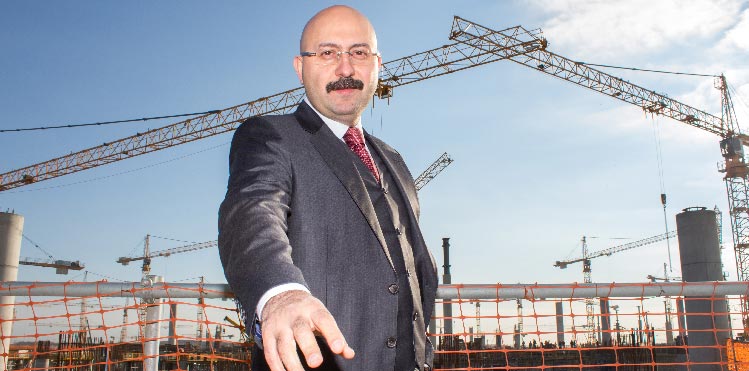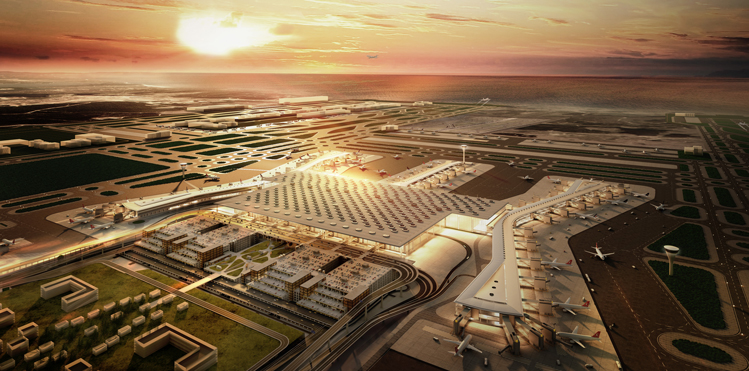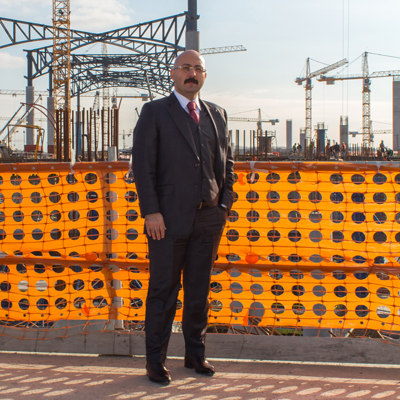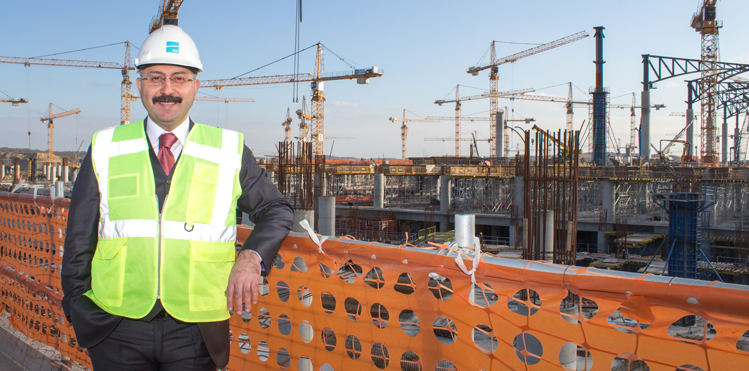In August, the İGA Airport Operation appointed Hüseyin Keskin as CEO of İGA Airport Operation – a distinctly different role from Yusuf Akçayoğlu who is CEO İGA Construction, and is therefore purely tasked with delivery of the project. Airport Business talked to Keskin to test the two key strands of the new airport’s strategy: Is it still on time for a February 2018 opening; and does it still plan to be a “world’s biggest” hub?
An interview with Hüseyin Keskin, CEO of İGA Airport Operation. By Paul Hogan

Hüseyin Keskin, the new CEO of İGA Airport Operation is a hands-on operations man with extensive experience of running the nuts and bolts of the Istanbul hub: previously he was Head of the Ground Operations at Turkish Airlines and, most recently, the General Manager of TGS, Turkey’s largest ground handling company.
Hüseyin Keskin is indeed very much a hands-on operations man with extensive experience of running the nuts and bolts of the new Istanbul hub. Previously, he was Head of the Ground Operations at Turkish Airlines and, most recently, the General Manager of Turkish Ground Services (TGS), Turkey’s largest ground handling company which is jointly owned by Turkish Airlines and TAV Airports.
Consequently, Keskin’s job is to see the new airport come to life in first-quarter 2018, and continue its operation and commercial success thereafter.
While this year’s “events” have produced a significant range of shocks to the Turkish air transport system, Keskin does not think these are permanent and he does not believe his mission has been deflected from steering the biggest hub in Europe by the early 2020s.
“The aviation sector reacts quickly to global and regional crises, it shows immediate reactions. But on the other hand, it renews itself fast and continues to grow as before. Although recent events have affected traffic, investments in tourism, technology and industry in Turkey show that the aviation sector will continue to grow,” says Keskin, who maintains there have not been any changes to the timelines for the Istanbul New Airport (INA) development.
“As the world’s 18th largest economy, and Europe’s 7th, Turkey is well positioned financially, well prepared technically, and committed with even greater resolve to the programme. İGA continues to work at full speed, in fact the construction of INA has even been more accelerated. We are sure that the aviation sector will get back to high growth rates, paving the way for INA to become the biggest hub in Europe by the early 2020s.”
Indeed, Keskin is bullish enough to talk specifically about top world airport rankings: “INA will overtake London Heathrow – even if Heathrow gets its third runway by 2025, because it is better located to be a major global hub” says Keskin referring to the competitive position mid-way between the traditional north European hubs and the new hubs in the Middle East.
“Istanbul has its own strategy based on unbeatable geographic advantage – there are more than 200 destinations in Europe, MENA and Central Asia, which Turkish Airlines and other airlines can serve with a narrow-body fleet.”
To this natural advantage Keskin relates how all the construction effort is aimed at adding considerable operational benefit: “There will be no capacity constraint at the new airport, and no restriction on any airline which wants to achieve maximum on-time performance. After the first phase of construction is completed in early 2018, INA will have the capacity to host 2,000 flights a day, and over 90 million passengers annually carried by 150 airlines serving more than 350 destinations. In the initial phase the airport is going to have three runways, but when all phases are completed, it will be able to handle 200 million passengers with six runways and offer the world’s largest terminal complex of 1.3 million square metres where, for the first time, all carriers will be able to board their aircraft by jet bridges.”
“Big bang” and the move to the new airport

Opening Q1 2018: “We are planning to have a ‘big bang’ transition from the current Atatürk Airport to the new one which means a transfer of operation – in just a couple of days.”
Keskin dismisses suggestions there will be a Qatar-style phased opening of the new airport during which the existing airport will remain open. “We are planning to have a ‘big bang’ transition from the current Atatürk Airport to the new one which means a transfer of operation in just a couple of days. The ORAT (Operational Readiness and Airport Transfer) period will start 12 to 15 months prior to the airport opening date, while trials of all the systems and buildings will start six months before the opening.”
As a leading ground handling specialist Keskin also relates how opportunities are being fully taken to bring in new methods which will produce both efficiencies and reduce ground handling vehicle emission: “Besides following a green airport concept, we are also discussing centralised services and alternative push-back systems. Providing trouble-free handling services – ranging from passenger experience, to cargo, to hospitality services, to duty-free services – is of great importance to us. We will provide all kinds of innovative facilities enabling airlines to increase their efficiency – and so that their unit costs will also be reduced. In all these things, while we seek excellence, we stay committed to the rates and tariffs set by DHMİ (Turkish General Directorate of State Airports Authority).”
With his background at TGS, Keskin confirms that İGA may consider plans for investing in a similar joint venture ground handling company. “We have been in contact with leading ground handling companies from all over the world. We are still evaluating whether to set up a joint venture or not. Our final decision will be taken in the coming months.”
So how smart will the passenger journey be?
Keskin believes that in the new airport “smartphone users will be in absolute heaven” and backs up his assertion with an extensive list of features: “Istanbul New Airport will be a centre of IT innovation, offering a comprehensive set of solutions to enhance passenger experience: self-service with biometric features, A-CDM (Airport Collaborative Decision Making), facility management with BIM (Building Information Modelling) and virtual reality, augmented reality, beacon and geo-location technologies, smart kiosks, social media-enabled services, airport gaming, loyalty services, queue management, iBeacons will provide indoor directions, walking times to gates, lounge access and boarding alerts, and a seamless Internet of Things framework will communicate with smart infrastructure to deliver a more efficient and effective user experience. At INA technology will dramatically change the way we fly – and run the airport.”
“World’s best shopping environment” (and Turkish experience)

“We have worked very closely with Unifree on detail to create the best design among the global airport hubs. It will offer a very diversified shopping concept called ‘City of Facets’, capturing all the fascinating colour that makes the city of Istanbul memorable and unique.”
Commercial/retail spend per passenger at Istanbul Atatürk Airport was €15 in 2015, and therefore considerably outperforms the European average of €10.4. So it is unsurprising that Keskin agrees that retail has played a central role in İGA’s business strategy from the earliest days of the new airport’s planning. It also explains why the Unifree/Gebr Heinemann deal of January 2015, billed by İGA as “the world’s biggest duty free agreement” was among the very first contracts signed.
“Our aim is to provide air travellers with the best shopping environment in worldwide travel retail. Unifree/Gebr Heinemann is investing €120m to gather over 400 domestic and international luxury brands under one roof. But it’s not just about size: We have worked very closely with Unifree on detail and have created the best design among global airport hubs. It will offer a very diversified shopping concept called ‘City of Facets’, capturing all the fascinating colour that makes the city of Istanbul memorable and unique.”
Lovers of great Turkish confectionery, teas and other fine local produce will be relieved that these will not be submerged by global brands, and this is important for other reasons – as much as 50% of Turkish Airlines’ Istanbul traffic is transit; for many of these users shopping at the airport will be their only taste of Turkey. Equally Keskin promises an F&B offer with “a mix of global tastes combined with our own very rich Turkish cuisine heritage.”
Environmental impacts at new site

Hüseyin Keskin, the new CEO of İGA Airport Operation: “Istanbul New Airport will have unbeatable competitive advantages over the Gulf airline hubs – it reduces flight time, it introduces the flexibility to use a variety of aircraft of diverse capacity, it provides considerable cost advantage, and contributes to competitive superiority. From Istanbul, it is possible to reach more destinations than any other competitive hub!”
“It is not only construction that has to be eco-friendly, but operations, too. Istanbul New Airport will be operated as a ‘green’ airport. A green-airport-certification scheme by the Turkish Civil Aviation Authority will be implemented, and all tenants will also obtain Green Enterprise Certificates under the same scheme,” explains Keskin.
The new airport site on the Black Sea coast, north east of the city, is sparsely populated, but presents a challenging construction environment of disused open-cast mines from an abandoned industrial past. An Environmental Management department was one of the first created at İGA, working in collaboration with local and international bodies since early 2014. This followed one of the board’s first decisions of May 2013, just after the tender award, to carry out an environmental and social impact assessment study “to the highest international standards” with Ramboll Environ.
“The studies are thorough and were conducted over a period of two years,” explains Keskin. All the commitments, procedures and offset projects are based on the result of this study, including a biodiversity action plan committed to a one-to-five ratio for every cut tree. Meanwhile, for both environmental and reasons of bird-strike hazard, a study is being conducted by a team of six ornithologists working full time to collect data on birds flying around the project site. “This will allow us to structure a reliable, state-of-the-art, wildlife management programme to international aviation standards for flight safety, and also to protect wildlife.”
Overall, Keskin maintains that “flora and fauna protection projects have been underway since spring 2014 – without even waiting for the finalisation of the impact study – and İGA continues to constantly monitor potential effects on the environment or animal habitat,” says Keskin.
Meanwhile, the main terminal building has been designed according to USGBC’s (US Green Building Council) LEED Certification scheme. İGA has also modelled potential impacts of future noise and air quality and shared the findings with the Istanbul Greater City Municipality for consideration in future development plans.
However, Keskin admits that the new airport will have to match its pace of growth with new environmental targets: “Air transport has seen tremendous growth in the past 25 years, and will see more in the years to come, especially in Asia. So in future we will see more innovation at airports to address CO2-concerns: hybrid and electrics engines will help lower overall emissions, while in the air traditional kerosene could be phased out in favour of ecofuels and new materials will make planes lighter, more efficient, and less noisy. All these developments will ease the air travel for passengers and help reduce the environmental impact of aviation.” (ACI EUROPE expects that the new Istanbul hub will also follow the example of its counterparts in applying for certification from the Airport Carbon Accreditation programme, to gain global recognition for its efforts in both energy efficient construction and airport operations.)
A better hub than Middle East competitors?

Keskin: “I am very focused on attracting new carriers to our new airport…we will provide all kinds of innovative facilities enabling airlines to increase their efficiency and reduce their unit costs…it will be a centre of IT innovation where smartphone users will be in absolute heaven.”
Unsurprisingly, for an executive tasked with being “CEO of İGA Airport Operation” Keskin agrees “I am very focused on attracting new carriers to our new airport – there aren’t enough airlines flying from the current Istanbul Atatürk Airport to the Americas, China, India, Africa and Southeast Asia – except the hub carrier Turkish Airlines – we want new carriers flying from those regions.”
As Turkish Airlines will be the biggest customer and anchor tenant at the new airport, Keskin agrees “very high levels of coordination with between İGA and Turkish Airlines were settled just after the completion of the tender process.”
He again reasserts the geographic advantage Turkish Airlines has to serve over 200 feed destinations with a narrow-body fleet: “They are capable of flying to more destinations in Europe than any other airline, and having far more frequencies to popular destinations. That means far more choice and connections for passengers for transfer to wide-body long-haul operations to Eurasia, Africa, the Americas and Far East. With the world’s 4th largest flight network, Turkish Airlines currently flies to 218 international destinations in 108 countries. This country coverage is greater than any other airline in the world!”
Keskin’s list of Istanbul New Airport’s advantages as a transfer point on global routes for airline users and travellers continues: “It reduces flight time, it introduces the flexibility to use a variety of aircraft of diverse capacity, it provides considerable cost advantage, and contributes to competitive superiority. From Istanbul, it is possible to reach more destinations than any other competitive hub in four hours due to the country’s geographic location. For İGA and all of our customers this brings unbeatable competitive advantages over the Gulf airline hubs.”
Despite Turkey’s 2016 “events” Istanbul airport traffic declines are less than you would think
In the 21st Century Turkey’s airports have excelled on the back of stellar economic performance, booming tourism, a tenacious Turkish Airlines hub strategy, combined with the wholesale modernisation of Turkey’s airports through adventurous privatisation initiatives.
Since 2000 Istanbul Atatürk Airport has been propelled from an “also-ran” airport of 10 million to become the third largest in Europe after Frankfurt at the end of last year (with 61.3 million passengers). Growth has been very real and sustained – in the five years 2010-15 Istanbul Atatürk grew by an average 14% per annum, and Istanbul Sabiha Gökçen Airport, an entirely new operation opened in 2001, grew by an incredible annual 20% to reach 28.1 million last year.
To create the airport capacity needed to provide for a place at the top table of world domination, expected soon after 2020, in 2013 the government awarded a new 25-year concession for a €10.2 billion, six runway airport to the İGA Havalimanları consortium, with the first three-runway phase scheduled for opening in February 2018.
But, simultaneously with Istanbul’s promotion to the top three airports in Europe, this momentum has been impacted by a series of external setbacks: The falling out with Russia, increasing incidents of terrorism, culminating in the June attacks on Istanbul Atatürk Airport itself, the bizarre coup attempt just two weeks later, itself then followed by Turkey’s direct military intervention in next-door Syria.
There have been instant airport traffic consequences – Istanbul Atatürk was immediately down 8.5% in June and 5.8% in July. But traffic has not fallen off a cliff as it has in Antalya, where the near-absence of Russians has seen 40% peak-season declines (although Antalya’s traffic is widely expected to resurge next year following the rapprochement with Russia, and the lifting of the ban on Russian charter flights).
As we approach the end of 2016, Turkey’s airports are improving overall: rising from -15% in June, to -13% in August, to -8% in September, and now “only” -3% in October, producing an overall result of just -4.8% down for all Turkish airports by end-October.
Turkish Airlines itself, for whom İGA is largely building the new hub, has published a Winter 2016/17 schedule which reflects a capacity decline of just -3%. This is almost entirely produced by reduced frequencies, rather than axed routes, and significantly, there have been no changes at all to its African network which is a specialism of the Istanbul hub (apart from the addition of Seychelles in October, Turkish Airlines’ 51st African destination).
Indeed, declines in Istanbul’s airport system are showing definite signs of slowing – in the year to end-October Istanbul Atatürk Airport is showing only a 2% decline, while Sabiha Gökçen Airport reflects 6% growth!







